 There are many possible sources of intimacy, and not all of them are with people! Many of us experience deep emotional relationships with plants. Here is a collection of plant love stories that tell some of the many ways people affiliate affectionately with plant beings.
There are many possible sources of intimacy, and not all of them are with people! Many of us experience deep emotional relationships with plants. Here is a collection of plant love stories that tell some of the many ways people affiliate affectionately with plant beings.
Drawing a plant brings me a sense of sweet intimacy with every shape and curve of its bodily beauty. Dreaming about Marigold and Magnolia takes me into the plant spirit world. Obtaining ceremonial objects from White Cedar and Hazelnut, I experience a grateful reciprocity of giving and receiving. One of my son’s favorite childhood memories is of picking and eating Eugenia berries from one tree, kumquats from another, and wild “miner’s lettuce” on our walks to preschool in San Francisco.
“In the end we will only conserve what we love,” says Baba Dioum, a Senegalese conservationist. Biologist E.O. Wilson encourages us to save biodiversity by recognizing that we humans have an innate propensity, extending all the way back to our pre-human ancestors, to experience deep emotional satisfaction from tending to the welfare of the rest of life, that he calls biophilia.1
It is said that in order to restore the natural world we must restory it. So, I wrote to some friends: “The darkness and cold of winter invite us indoors to more interior, contemplative modes of being. I would like to invite each of you to reflect on your memories of a close relationship with a beloved plant. Please consider writing a story about your special experiences with one particular plant or your love for a favorite tree. If it’s a native plant, so much the better, but it’s the connection between species — you and the plant — that matters. I will compile them for a Valentine’s Day post.”
I’m grateful for the many responses, so varied and enthusiastic — stories, vignettes, poems, drawings, paintings, and photographs. I’ve arranged them into Plant Love and Tree Love. Together they reveal to us many possibilities for entering intimately into the field of energy of plant beings. Give a plant near you some love today!
Plant Love: Ann conveys the spirit energy and visual delight of Gaillardia. Barbara wafts to us the soul-soothing scent of Black Sage. Barb reveals Skunk Cabbage as her connector to ancestral lands. Brian’s affectionate teasing of Heal-All charms us. Margot unveils a glimpse of the otherworldly and ephemeral beauty of Virginia Bluebells. Trout Lily puts Lib in touch with Creation itself. Robin’s meditation explores ways of journaling and sketching that connect her with Columbine. Sue graces us with drawings depicting Winterberry’s gift of friendship.
Tree Love: For Laurie Elderberry is a medicinal mentor who helped her cope with grief. David shares a childhood memory of a secret protective grove of poplar trees. Mariah’s haikus in praise of Sycamore impart joyful enthusiasm. Sandra discloses to us how she maintains connection with her beloved grandmother through her trees. Nancy voices a blessing of winter moons given to her by Tulip Poplar. Ken’s ode to Post Oak testifies to what trees can mean to a community. Marj’s gratitude and love for her Pecan tree express a sense of home — for her and millions of others!
Plant Love Stories
Gaillardia Pulchella
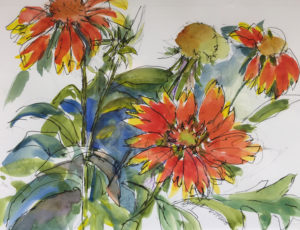
I’m very fond of Gaillardia pulchella. I’m not sure why as I’m usually partial to blue and lavender colors. (Scutellaria ovata – heart leaved skullcap is another favorite). I suspect it is something about the spirit energy of the Gaillardia plant. I first saw Gaillardia in the wild in Wyoming about 30 years ago. It was in a dry sagebrush desert environment and was more yellow than red. I was traveling with my young son and pointed it out to him, but he was more interested in climbing on the nearby boulders. I still have photos of that plant – and of course my boy on the top of the biggest boulder that a 6 year old could manage.
I am enamored of the way the petals narrow down to a point and attach to the flower head just so. I am fond of the fuzziness and the reddish burnt sienna color of the flower head. I like the way a bit of yellow shows when petals are first emerging. They are so tiny and stiff and cute just coming out. There is a stand of Gaillardia pulchella or some cultivar of it planted in the garden outside the Education Center at the North Carolina Botanical Garden. I have made trips to the garden in early summer just to admire the Gaillardia.
– Ann Gayek
Black Sage
In southern California, the plant that has sustained me, with joy, is Black Sage, Salvia mellifera. Its strong aroma, tangy, insistent, brings peace to my soul. Growing in the desert of this quite arid mostly brown-hued region, Black Sage can survive with its tough springy small leaves, all the burnt summer long.
I used to like to go to the coastal mountains, hike on a favorite trail, and stand next to Black Sage, rubbing my fingers into a few leaves (not stripping them off of the plant, not even wasting one leaf like that), and then just inhaling the scent off my fingers. Soothing to the soul, a very sustaining plant, a friend. Then, before going home, I would talk to several of these vibrant sage bushes, and from a couple of them, I would take a leaf or two, stuff the fragrant leaves in my pocket, and bring them home. They would last a long time, and as they dried out, they still smelled vibrant, strong, bracing, for many days. A soul friend plant!
– Barbara Janeway
Skunk Cabbage
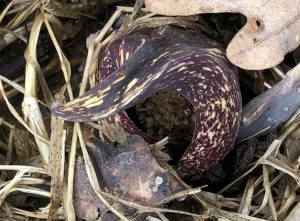
As a young child, I spent so much time playing among the maples, oaks and sassafras behind our house in northeastern Ohio that Mom and Dad named the hillside Barby’s Woods. A path led up through the gently sloping woodlot, ending at the upper meadow where Dad once planted potatoes. In a depression that ran alongside the path lay an ephemeral stream, muddy in spring, mostly dry by late summer. But further up was a larger area that remained muddy into the fall, a kind of woodland wetland I have since learned is quite rare, an “upland depression swamp.” This was the home of a colony of Symplocarpus foetida, aka, Skunk Cabbage.
In the very early spring, even as snow still blankets the ground, the heat self-generating Skunk Cabbage pokes its narrow, maroon spathe up through still-frozen soil. Each spathe hoods a spongy spadix dotted with dozens of tiny rotting-meat scented flowers visited by flies, bees, spiders, and carrion beetles. As spring turns to summer, the spathe dissolves and is replaced by lush green leaves, each one wrapped around the next. Younger plants have two or three leaves, but older plants–perhaps decades old–produce a ring of stalked leaves reaching upward to three or four feet tall.
As a child, I must have found the plant fascinating, for one summer day I played amongst the colony and carried the fetid scent home on my clothes and hair, requiring many washings and a warning from my mother not to go near it again.
Seventy years later, the Skunk Cabbage still flourishes. If I make my annual visit as late as Labor Day, so I can attend the Geauga County Fair, I will find that the leaves of the Skunk Cabbage have mostly disappeared, the contractile roots having pulled the plant deeper into the muck.
I like knowing that this unusual plant, which evolved millions of years before humans walked the earth, has found what I hope will be a forever-home on my ancestral land. As I write this in December 2020, northeastern Ohio has already had its first snowfall of the season and more is on the way. As treacherous as this can be for cars, it is no problem for the Symploycarpus foetida. It is hunkered down, readying to poke through even frozen earth and bloom as the first flower of the Ohio spring.
-Barb Stenross

Blossom Dearest
Oh, that I had found you first
before that
dullard
hung the weight of this name
Prunella vulgaris
on your sweetly robust beauty
and multitude of healing charms.
Heal-ye-all-us magnificans!
-Brian T Stokes
Winterberry

Gaultheria procumbens (Eastern Winterberry, American Wintergreen, or Boxberry) is an easy-to-grow, shade-loving ground cover. In my garden, Winterberry widens its cheerful presence year-by-year in two shady spaces. This hardy little scrambler first arrived on my doorstep almost two decades ago—in a holiday package sent to me by a distant friend. That single plant has now populated a well-drained, narrow, sloping area along the foundation on the south-facing side of my house. Then, a couple of years ago, a local friend gave me a second plant. This second Winterberry, planted in a raised bed near a native beech tree, has also happily rippled outwards in rhizomatous eagerness. It doesn’t seem to mind the competition from the hungry, matted tree roots.
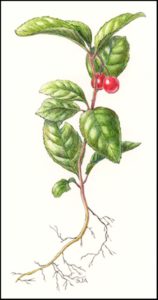
I love my Winterberry patches! On cloudy, grey days in December and January, the vibrancy of the color of the red berries seems to be intensified. Generous in their plumpness, they dangle companionably from the leaf axils on thin, delicate stems, beckoning me to come closer. The shiny round orbs peek out amiably through the leathery green foliage. They invite me to pause a while and to reflect on the glowing, bright heartiness of their freely offered winterberry cheer. I lean in—and I smile! Their evergreen presence in my garden reminds me to cherish the gift of enduring friendships—both botanical and human.
– Sue A.
My Memory of Virginia Bluebells
There is a plant I dream of having in my garden, and I just may have found a spot for it: a down-slope place of dappled sunlight, and home to Mayapple, Atamasco-lily, and Blue-eyed Grass. I will forever remember my first encounter with Virginia Bluebells. It took place during a weekend getaway to a restored Shaker village set among the rolling hills and pastureland of Kentucky’s limestone country. Occasionally, our visits to Shakertown at Pleasant Hill included a boat ride on a small paddlewheeler, along a stretch of the Kentucky River from which, in centuries past, Shakers shipped packages of seeds and other goods downriver to its confluence with the Ohio, and from there to southern markets.
A steep and narrow gravel road led down a fern-lined gorge to the boat dock. But on this particular spring day, we chose to take a trail through fields and woodland that led to the launch point. Midway between the hilltop village and the river, we found ourselves passing through a moist, terraced meadow filled with lush grasses and Virginia Bluebells at the peak of bloom. It was an experience akin to entering the technicolor Land of Oz; the colors of the landscape were particularly intense on this blue-sky day. The interplay between the bluebells’ nodding, dainty, trumpet-like flowers, tiny clusters of still-pink buds, and wavy, pale-green leaves was as alluring as a fairy’s gown. The sight was both other-worldly and truly ephemeral. Not many days after, this gorgeous meadowful of bluebells would quickly vanish from the scene, leaving no evidence of its splendor until reappearing the following spring. But my memory of the beauty of bluebells will linger everlasting.
-Margot Ringenburg

Kneeling in Joy
One day in January, 18 years ago, I had a birthday and decided to purchase a “good” camera, as in film back then. This camera was a gift to myself for turning 60. Knowing how much my curiosity led me off the main paths, my family and a friend pooled their funds and purchased a macro lens and that’s how it all began.
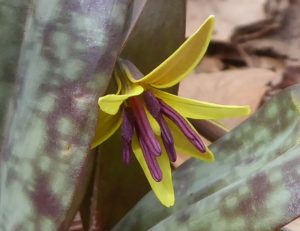 A dear friend introduced me to the tiny yellow wildflowers as we walked near the creek at a Triangle Land Conservancy preserve in Raleigh. It was February and she told me that the Trout Lilies were starting to bloom. Indeed, leaves were sprouting up and a few had bloomed. A week later, they covered the ground and fuchsia-colored stamen hung from their fragile centers and I just needed to get a photo, right? It seemed as if they were spring’s surprise gifts at a time of longing and deep need for connection with the beauty before me.
A dear friend introduced me to the tiny yellow wildflowers as we walked near the creek at a Triangle Land Conservancy preserve in Raleigh. It was February and she told me that the Trout Lilies were starting to bloom. Indeed, leaves were sprouting up and a few had bloomed. A week later, they covered the ground and fuchsia-colored stamen hung from their fragile centers and I just needed to get a photo, right? It seemed as if they were spring’s surprise gifts at a time of longing and deep need for connection with the beauty before me.
I went home and got my mud boots, knee pads, plastic cover for the camera in case it rained, and went back to those gorgeous bright yellow petals that covered the forest floor, knelt down in the mud and just as I was snapping the photo, a honey bee with legs full of pollen landed on the stamens. I’ll never forget the moment that I felt I was kneeling before the Great Source of all Creation and have found Trout Lilies under many other trees since then, but that moment was the most special.
-Lib Hutchby
Beholding Columbine
Over a decade ago I spent a week sitting with a native Western Columbine (Aquilegia formosa) I had planted in the yard while exploring a course in shamanic herbalism. Breathing in and out together, I observed the changes in the plant over the course of the week, remembering to say “thank you” to her each day for allowing me this time together.
From my first day observation notes:
The young Columbine is dappled with sun and shadows, with leaves of green, some triplets, a few singular. I wonder why- are the single leaves on a budding stem? A dandelion seed swings from an invisible thread. A small bud at the top shows tiny rounds. A microscopic bead of liquid catches the sun. The plant trembles in the breeze as the long broad dandelion leaf behind it sways more urgently. There is perhaps another new bud caught in the folds of new growth near the ground. A fly or mason bee patrols near the base looking for something. The urge arises in me to clear a level space behind the columbine flattening the hillside on which she sits, perhaps helping her to catch more water before it drains away. A small thin thread attaches the top bud to its leaf — I catch it when the angle is just right. A shadow of one of her leaves is caught on a lower leaf.
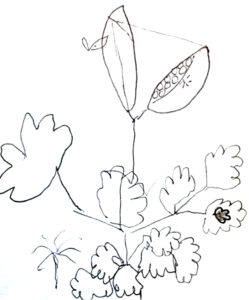
I wonder how my connection to my garden will be transformed if I sit with every plant this way?
While sitting on the second day I contemplate the power in her delicacy and her easily crushed vulnerability. I muse on different ways of beholding a plant; beholding with a critical eye- examining, analyzing; beholding with a neutral eye- naming, describing; and beholding with a loving eye- soft focusing, witnessing.
I notice the larger leaves are more deeply indented and more numerously lobed. A few pink buds are beginning to emerge from light green small unlobed leaves. A small fairy insect is perched on a leaf. And then I content myself with exploring with a more softened focus (without my glasses) beholding with love, holding a crumpled leaf flattened out in my hand.
I ask Columbine, have you something to tell me? And wait for an answer that may or may not come in words.
On the following days I observe the flower showing her coral color as she begins to open. More buds, a small spider, several aphids, glittery slime lines and a small black bug burrowing in the dirt also appear. I contemplate the arrangement and shape of her various leaves. A message arises, “Look me up in your books. Observe my elder neighbor Columbine for comparisons” and so I do.
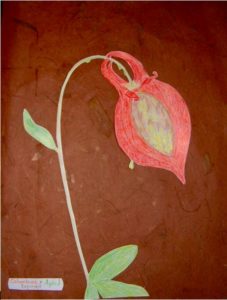
I notice the aphids have nibbled the first flower leaving a gaping hole into her interior. I find I cannot resist gently whisking the aphids away even as I sense I am fiddling with an interconnected web of life. I honor this first flower’s generosity in nourishing the aphids with a colorful drawing.
A decade later, Columbine still graces my garden, now on the opposite coast. In my desire to have a familiar friend greet me in my new home, I found a native Eastern columbine of the same color (Aquilegia canadensis) to plant here. I am delighted when new seedlings appear in unexpected places. I find that once I sit beholding a plant, their spirit continues to touch a place in my heart, delightfully catching my attention whenever we find ourselves together.
-Robin Rogers
Tree Love Stories
Elderberry
 Elder was my initiator into the world of herbalism at a critical time in my life, as I was about to lose my mother that year, unbeknownst to me. Elder showed up as a volunteer in my back yard near an ephemeral pond. It was my practice at the time to allow any plant to grow there in order to “see who shows up.” I was pleased to see the young plant grow quickly into a large 20′ shrub, and I was delighted to enjoy the lovely white, large blossoms that appeared in a lacy flat form one spring.
Elder was my initiator into the world of herbalism at a critical time in my life, as I was about to lose my mother that year, unbeknownst to me. Elder showed up as a volunteer in my back yard near an ephemeral pond. It was my practice at the time to allow any plant to grow there in order to “see who shows up.” I was pleased to see the young plant grow quickly into a large 20′ shrub, and I was delighted to enjoy the lovely white, large blossoms that appeared in a lacy flat form one spring.
A local herbalist, Riverdave, identified it as an Elderberry bush and said, “Just pick a few flowers (they were so abundant!), then soak them in vodka for a few weeks, shaking the jar occasionally, and you will have an herbal remedy!” I was really intrigued and excited to be introduced to this kitchen witchery, and I followed his instructions and soon had my remedy.
I read up on Elderberry in a Matthew Wood book,2 and I found out what a powerful plant mentor and guardian she is. She is known to take a tutelary role and to protect and teach all the other herbs in the garden. And she certainly has done that for me in countless ways. Not long after I connected with Elderberry, I began a three-month course in herbal medicine making with the Chestnut School of Herbal Medicine. I was hooked! I went “plant-crazy” and found myself obsessed with growing, harvesting, foraging for, and processing herbs in a completely unexpected obsession, an obsession that continues to this day. That was in January, and later I signed up for their longer herbal immersion course.
And when my mother passed away shortly after that, I received such comfort and love from the herbal world. At the time, my mother was living at an assisted living facility. I visited her and took her out to lunch once a week. She turned 91 in February and was doing well. Imagine my surprise to get an early morning call in April telling me that she had passed peacefully in her sleep in the wee hours. When I arrived, I saw that she was curled up a bit, in the fetal position of neolithic burial. Of course, I went into shock and alternate reality for coping. But luckily, I had my herbal obsession to fall back on.
I’m sure that Elder was guiding me through this experience, because according to early European herbalists, Elder was a gateway between the worlds, between life and death, a guide, a teacher, a compassionate “elder.” Soon I became an herbal apprentice with Lea Clayton, a local herbalist who has an herbal farm in nearby Saxapahaw. Five years later I’m still in a most wonderful herbal apprenticeship group of women, and I treasure our friendships and support as well as all the learning and development. I’ll always be grateful to Elderberry as a tutelary and shamanic plant who initiated me into this vast and amazing world of Plant Beings. I feel so blessed by my encounter with the powerful initiation I received from Elderberry, the Mentor of the Garden.
-Laurie Lindgren
My Secret Grove
I grew up in rural Des Plaines, Illinois, a Chicago suburb. My grade school was about a mile from my home. I usually rode the school bus to and from, but around the age of ten I sometimes liked to walk home. In that case I usually took a shortcut along a path that ran diagonally across a huge open field, through which ran a small creek. At some time in the past someone had built a simple bridge across it, spanning about ten feet. One afternoon on my way home as I reached the bridge a small, dense grove of trees clustered together several hundred feet up the creek on my right caught my eye. I decided to investigate, and when I reached them, I stopped to play in the trees and the water. The creek was only a couple of feet wide and very shallow at that point.
Thus began my love affair with these friends. It was as if in that grove I had found my secret spot, one where I was cozy and protected. I built a small walkway of branches across the creek. The trees were some kind of poplar – tall and thin, with branches that rose up rather than spreading out. As I recall the scene now, they were probably only ten or fifteen feet tall, but at the time, though no trunk was thicker than my arm, they seemed much larger and powerful. In warm weather I loved sitting there and listening to the water, and when there was a breeze I could also hear the trees rustling. I felt so safe and secure in this magical grove.
-David Chaika
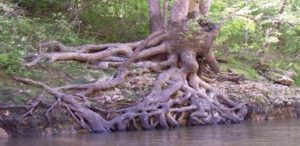
Sycamore, My Friend
BIG is the word! Sycamore (Platanus occidentalis) is a towering tree up to 167ft tall and 13ft in diameter. Full-grown leaves can be 8 to 12in wide. Sycamore’s leaf canopy can spread to 70ft. Sycamore grows rapidly. The bark near the ground, typically grey-brown, becomes scaly and flakes off in thin and sometimes large, varied – tan/brown camouflage tones. The branches above are pure white against blue sky.
Leaves are broad and lobed, pale green at first. They become bright yellow green above and paler below at maturity, and they turn brown and wither before falling. One-inch ball-shaped fruits hang all winter. They fall apart in early spring, 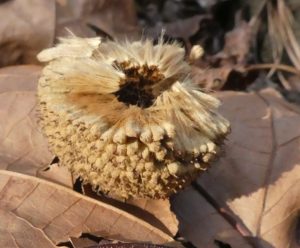 scattering seeds from their “parachutes.”
scattering seeds from their “parachutes.”
Along riversides, old Sycamores often have hollow trunks providing animal dens or play houses.
My dense-shading friend
round and white, your Latin name
must be Syca-moon!
 Broad leathery leaves,
Broad leathery leaves,
white alternating branches.
 No hand lens needed.
No hand lens needed.
Life is good for you
exuberant sycamore
bursting out in joy!
– Mariah Wheeler
Her Enchanted Trees

I have magical memories from times spent at the home of my beloved grandmother, Mam-mamma. Her Christmas tree was always adorned with “angel hair” that reflected the softly colored lights underneath. A Santa head light, a cluster of grapes lit from within, a light blooming inside holly leaves and berries. In the spirit of those childhood seasons, I stood in adoration of her beautiful, artful Fir tree.
She had a full-grown Pecan tree in her backyard there in Montgomery, Alabama. It was a Paper-shell Pecan, easy for me to break open and eat one of its nuts on the spot. I have an image that lives in my mind today: It is fall, probably Thanksgiving weekend. I’m around seven or eight, standing under that big Pecan tree, having picked up and opened one of those sweet nuts. Munching that fresh pecan is pure pleasure.
Down the street from Mam-mamma was a Mimosa tree. No, not a native, but when I was a child, all I knew of that tree was that it was a magical place for me, sitting in the crook of a low branch, brushing a fuzzy bloom against my cheek, transported by the softness and fragrance and peace of the moment.
– Sandra Brooks-Mathers
They Have Stories to Tell
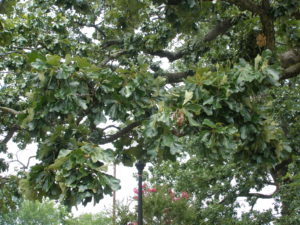
I have so many favorite trees and places, it is difficult to focus on a single one, and I tend to favor those that have lessons relative to tree and human interactions and how, so frequently, the future of mature and majestic trees rely on a few thoughtful individuals who remain vigilant to societal attacks on these giants among us.
I don’t think a day goes by that I don’t reflect on a former Weaver Street Market (Carrboro) staffer’s response to my description of visiting the 200-plus-year-old hollow Tulip Poplar, still standing vigil in Stillhouse Bottom Nature Preserve.
Following my reverential description of feeling that we humans will never live to experience as much of life as that aged forest giant, she softly responded that there’s an aged forest sentinel tree near her home that she frequently visits. And then, somewhat timidly, she described that those old monarchs of the forest “have stories to tell and if we stand quietly enough, long enough, they’ll tell us some of those stories.”
That was in 2012, the same year it was reported that the giant 250-plus-year-old Post Oak across from Carrboro’s Century Center was assessed as a “Hazard Tree” because of a hollow trunk. A tree company for the Town of Carrboro determined that it needed to be cut down. After some citizens questioned the wisdom, and following assessments of independent arborists, the tree was determined not a “Hazard Tree, ” and thankfully the Town Manager backed away from felling the tree, in support of the citizen actions. However, with “history so quickly forgotten,” this situation resurfaced four years later, and again citizens spoke, independent arborists were consulted, and the Town Manager sided with the citizens. Now, in 2021, that tree still stands.
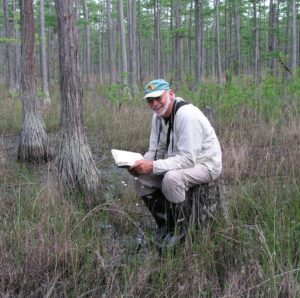
Many factors are involved in considering how hazardous a tree with internal decay may be. For instance, it is known that some species of trees, like post oaks, stand for decades with hollow trunks, providing useful shade and necessary habitat for critters like owls, bats, flying squirrels and hundreds of insect larvae, a necessary food for baby songbirds.
The Century Center Post Oak is not alone. It is one of many old post oaks, remnants of the original forest, beneath the canopy of which early residents of Carrboro built their homes.
Similarly, the Stillhouse Bottom hollow Tulip Poplar shares history with its honored contemporary, The Davie Poplar, on the UNC Campus. Nearby are a few other hollow giant trees, remaining from the original forest, that provide shade and necessary habitat for the barred owls observed nesting in the hollows of those mighty trees.
Each of us should pause from time to time beneath any of these giants, stand close, hug the tree, gaze upward and ponder “the stories they have to tell.”
-Ken Moore
TREE3
In Carolina September,
ninth lunation,
Coll/hazel in the
druidic tree alphabet,
I think of Robert Graves,
poet and lover
of the White Goddess.
I follow his practice of
bowing nine courtly bows
to Her full moon,
add four more for
all the year’s moons
(especially the cold ones
whom I hope to placate);
I bow too, in honor of
My Lady Tulip Tree,
Queen of a quiet grove
encircling our house.
Her royal lineage spans
fifty million Earth years;
Moonlight anoints
her skywoven crown,
burnishes her
trunk’s regal column,
seeps shining into the
earth at her feet.
When I ask for a blessing
of her long-lived wisdom,
a gold leaf message
drifts into my lap.
‟Daughter,” she writes,
‟Honor winter moons,
but do not fear them:
their ice prunes what’s dead,
and toughens the heartwood.”
-Nancy Corson Carter
Tribute To Tree
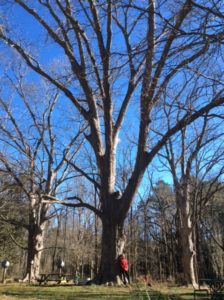
This glorious early Spring day screams for jubilant rejoicing! Cornflower blue February skies hang over a profusion of blooming flora, highlighted by bright sunlight. It seems that color has crept into the yard overnight, emerging from Winter’s long hold, to herald the sacred season of rebirth. Even an icy north wind can’t hold back the explosive magenta of tulip magnolia or the sunshine yellow of forsythia. Patches of wood hyacinths, low to the ground, bring soft lilac and powerful fragrance to the day’s dance. Purple and white crocuses smile up at me as I pass, happy to be among Spring’s first announcers. Splashes of coral quince further decorate this glorious day. Colors, fresh off the paintbrush of the Creator, burst forth with flaming glory, telling the news of the coming of Spring.
High above this chorus of color stands one lone sentinel, keeping a protective watch over all. It is an ancient Pecan Tree whose limbs tower toward the Heavens, triple the height of my house. Three adults clasping hands can barely encircle her massive trunk. She is the oldest living soul on the property, having watched all other life come and go for well over a century. In the midst of my exuberant rejoicing, I feel her pulling me into her presence. I walk to her, as always, with great reverence. With the sun beaming down on my back, I close my eyes and give her a long, slow hug. I ask Tree to tell me something. Anything. I just want some Tree wisdom today. My breathing slows to measured deep breaths as I relax into the presence of this majestic being. Arms outstretched, I hold her as best I can, pressing my heart against her rough bark.
I apologize to Tree for the short-sightedness of humans, for humans who look at trees in board feet rather than as Keepers of the Earth; for humans who fail to see trees as generous givers of nitrogen and oxygen and other gases necessary to sustain our lives, trees whose leaves are the most efficient solar energy collectors on the planet. I apologize for humans who do not recognize trees as our sacred brothers and sisters who magically create living cells out of thin air, rain and sunlight. I apologize for humans who have not yet learned to revere trees, who do not see trees for who they truly are — the great standing people upon whom our very existence depends.
I move myself into a place of loving kindness, and I simply send love to Tree. I love and love and love. Time slows, then disappears altogether as the sun warms my back, and peacefulness fills my being. I send her gratitude for the many decades she has stood vigil over this land. How many hurricanes has she weathered? How many snowstorms? Droughts? Who has she nourished with her crop after crop of sweet pecans? I think of the countless generations of birds who have called this tree home, building nests in the safety of her branches and raising their young to fledge from her limbs. And the hundreds of thousands of insects who exist at this very moment on her rough surface. I think of the millions of microbes, never seeing the light of day, that intertwine with her roots underground in symbiotic friendship. In my loving, I thank Tree for standing steadfast through time, for her perseverance and her unwavering goodness. I thank her for shade. Then I love, and love, and love some more.
I end my meditation with Tree and very slowly begin to pull away, still somewhat entranced. As I push myself back from her, she speaks! Her words are as clear as spring water, as if she were standing right beside me, which of course, she is. She says, “Drink some water.” Ah, such wisdom. Isn’t that just like a tree!
-Marj Marie
All stories and images (C) their authors, as cited. All other text and photos (C) 2021 Betty Lou Chaika
- Wilson, Edward O., Biophilia, Harvard University Press, 1986.
- Wood, Matthew, The Book of Herbal Wisdom: Using Plants as Medicines, Berkeley, North Atlantic Books, 1998.
- Carter, Nancy Corson, THE SOURDOUGH DREAM KIT : POEMS, Bellowing Ark Press, Seattle, 2003.
Margot Ringenburg
A lovely and varied collection of love stories, each one connected to the others by a common bond: the sustenance, comfort, and wonder offered to each of us by memorable close encounters with the natural world.
Betty Lou Chaika
Ah, Margot, if this project were ever to grow into a book I would surely ask you to write the blurb for the jacket!
Ann Kadenda
What a brilliant and beautiful Valentine’s Day tribute! Thank you for coming up with the idea and making it happen. I loved reading everyone’s contribution. You are truly an inspiration.
Betty Lou Chaika
Thanks, Ann. The inspiration comes from the fact that Valentine’s Day is my birthday. In the past it involved a number of losses for which I still grieve. Every year I try to find ways to get the attention off myself, focus on love rather than pain, and spread the love around!
Ann Gayek
Oh, such wonderful stories! Skunk cabbage, bluebells, columbine, trout lilies, heal-all. and more.
Elderberry, sycamore, and pecan trees. Thanks Ken for your wonderful story about the post oaks and the two tulip poplars standing as hollow trees for decades. I will go look for the Davie Poplar. Thanks Betty Lou for putting all this together. Wonderful!
Betty Lou Chaika
Ann, thank you! This project was a privelege and a pleasure. I am grateful to your and every one else’s enthusiasm, and love for plants. Your painting is such a lovely contribution!
Jill Over
Our close connections with non-humans in the natural world always touch me deeply. Our world is filled with wonderful wonders of beauty and joy!
Betty Lou, I am ever grateful for all you keep giving us.
with love and appreciation, jill
Betty Lou Chaika
Thanks, Jill. You have been such a way-shower, taking us into the beauty of nature and providing us with opportunities to experience the wonder!
David Chaika
What a beautiful and moving collection of stories! Thank you to everyone who contributed.
Betty Lou Chaika
Thank you, David, for your story and for your support throughout this whole website!
Perry
On this cold February afternoon, these colorful stories bring me hope that Spring will arise in green and gold and all the shades of the plants we love. thank you all. Perry
Betty Lou Chaika
And thank you, Perry, for adding your colorful visionary tale to the gathering!